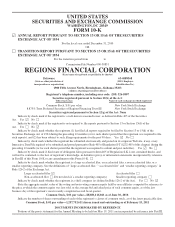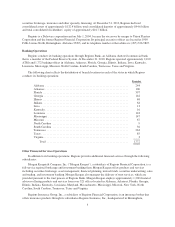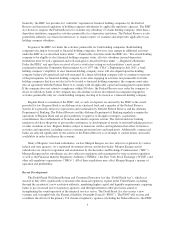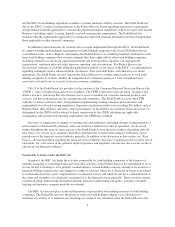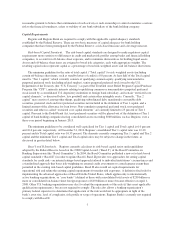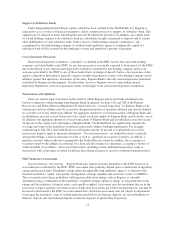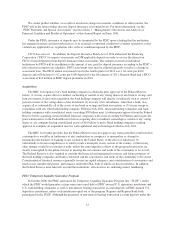Regions Bank 2010 Annual Report Download - page 20
Download and view the complete annual report
Please find page 20 of the 2010 Regions Bank annual report below. You can navigate through the pages in the report by either clicking on the pages listed below, or by using the keyword search tool below to find specific information within the annual report.and the SEC) in establishing regulations to address systemic financial stability concerns. The Dodd-Frank Act
directs the FSOC to make recommendations to the Federal Reserve Board regarding supervisory requirements
and prudential standards applicable to systemically important financial institutions (which we expect will include
Regions), including capital, leverage, liquidity and risk-management requirements. The Dodd-Frank Act
mandates that the requirements applicable to systemically important financial institutions be more stringent than
those applicable to other financial companies.
In addition to the framework for systemic risk oversight implemented through the FSOC, the Dodd-Frank
Act imposes heightened prudential requirements on bank holding companies with at least $50 billion in total
consolidated assets, such as Regions, and requires the Federal Reserve to establish prudential standards for such
large bank holding companies that are more stringent than those applicable to other bank holding companies,
including standards for risk-based capital requirements and leverage limits, liquidity, risk-management
requirements, resolution plan and credit exposure reporting, and concentration. The Federal Reserve has
discretionary authority to establish additional prudential standards, on its own or at the FSOC’s recommendation,
regarding contingent capital, enhanced public disclosures, short-term debt limits, and otherwise as it deems
appropriate. The Dodd-Frank Act also requires the Federal Reserve to conduct annual analyses of such bank
holding companies to evaluate whether the companies have sufficient capital on a total consolidated basis
necessary to absorb losses as a result of adverse economic conditions.
Title X of the Dodd-Frank Act provides for the creation of the Consumer Financial Protection Bureau (the
“CFPB”), a new consumer financial services regulator. The CFPB is directed to prevent unfair, deceptive and
abusive practices and ensure that all consumers have access to markets for consumer financial products and
services, and that such markets are fair, transparent and competitive. The Dodd-Frank Act gives the CFPB
authority to enforce and issue rules and regulations implementing existing consumer protection laws and
responsibility for all such existing regulations. Depository institutions with assets exceeding $10 billion, such as
Regions Bank, their affiliates, and other “larger participants” in the markets for consumer financial services (as
determined by the CFPB) will be subject to direct supervision by the CFPB, including any applicable
examination, enforcement and reporting requirements the CFPB may establish.
New laws or regulations or changes to existing laws and regulations (including changes in interpretation or
enforcement) could materially adversely affect our financial condition or results of operations. As discussed
further throughout this section, many aspects of the Dodd-Frank Act are subject to further rulemaking and will
take effect over several years, making it difficult to anticipate the overall financial impact on Regions and its
subsidiaries or the financial services industry generally. In addition to the discussion in this section, see “Risk
Factors—Recent legislation regarding the financial services industry may have a significant adverse effect on our
operations” for a discussion of the potential impact legislative and regulatory reforms may have on our results of
operations and financial condition.
Permissible Activities under the BHC Act
In general, the BHC Act limits the activities permissible for bank holding companies to the business of
banking, managing or controlling banks and such other activities as the Federal Reserve has determined to be so
closely related to banking as to be properly incident thereto. A bank holding company electing to be treated as a
financial holding company may also engage in a range of activities which are (i) financial in nature or incidental
to such financial activity or (ii) complementary to a financial activity and which do not pose a substantial risk to
the safety and soundness of a depository institution or to the financial system generally. These activities include
securities dealing, underwriting and market making, insurance underwriting and agency activities, merchant
banking and insurance company portfolio investments.
The BHC Act does not place territorial limitations on permissible non-banking activities of bank holding
companies. The Federal Reserve has the power to order any bank holding company or its subsidiaries to
terminate any activity or to terminate its ownership or control of any subsidiary when the Federal Reserve has
6



